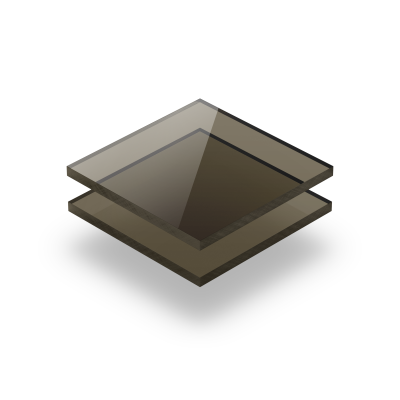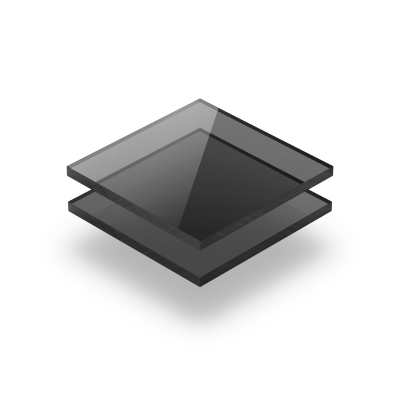Polycarbonate sheets can be bent or deformed both hot and cold so that the material can be used for many different applications. In this blog, we’re going to tell you everything about how polycarbonate bending works and the best way to tackle this process.
Polycarbonate bending temperature: the basics
Polycarbonate is a thermoplastic, which means that the material becomes soft when heated. Hot bending of Lexan polycarbonate can be done in several ways: with a professional bending device, a filament or heating element, a hairdryer, an adjustable paint burner, or a convection oven. However, cold bending of polycarbonate is much easier and is the more commonly chosen option.
Polycarbonate is very strong, so it doesn’t break easily if you bend the material cold. Of course, this also depends on the thickness and dimensions of the panel. For example, you’ll be able to cold bend a long, narrow polycarbonate sheet more easily than a small sheet, since a longer sheet will bend by itself.
Bending polycarbonate sheet without heating
Bending polycarbonate cold is handy if, for example, you want to make new windows for a boat. Because you can shape polycarbonate into a curve when cold, this material is often used for applications such as boat windows and windscreens.
Cold bending of polycarbonate is often carried out on a press brake, where the polycarbonate sheet is bent at a certain angle. When you bend Lexan polycarbonate cold, the material must be clamped in a shape, frame or construction so that the material doesn’t spring back to its original form. For example, if you’re replacing a boat window with polycarbonate, the rebate will keep the window in the desired shape.
When polycarbonate is bent professionally, the sheet is folded into the desired shape when cold and then heated in an oven at a low temperature (maximum 70 degrees). This process ensures that there is no more tension in the sheet and that the polycarbonate retains the new shape and therefore doesn’t spring back. For more complex forms, it’s essential to bend the polycarbonate with heat.
Heat bending polycarbonate sheets
Heat bending of large polycarbonate sheets should only be attempted by the professional and those expert DIYers with the right knowledge and experience. Professionals bend polycarbonate using thermal bending benches, heat coils and air circulation furnaces. The polycarbonate sheet is completely or partially heated, after which the sheet is bent into the desired shape using a mould. Once the polycarbonate has cooled, it will retain its new shape without support.
It’s essential to dry polycarbonate sheets before hot bending them because the polycarbonate may have absorbed moisture. If you don’t pre-dry the material, there’s a chance that visible bubbles will appear in the sheets. When you start drying, select a lower temperature than when bending, 110 to 120 degrees Celsius. Always remove the protective film first and then place the sheet in a convection oven for 6 to 12 hours. Make sure there’s enough space for the hot air to circulate around the sheet. You can also hang it up or partially raise it so that the air can get under the sheet. It’s not advisable to use a grid because it will leave marks on the surface of the polycarbonate.
Bending polycarbonate yourself
If you’re a DIYer and you want to bend a piece of polycarbonate yourself, but you don’t have a filament or heating coil, you can use an oven or paint burner. Before you start, lay wooden slats next to the folding line so that you apply heat to the polycarbonate in a targeted way. Doing this allows you to achieve the sharpest possible fold line. Then follow these expert tips for a successful result!
Tips for bending polycarbonate with a heat gun (adjustable):
- Remove the protective film from both sides and heat your polycarbonate sheet.
- Keep the outflow opening of the heat gun at least 5 centimetres from the sheet.
- Gently move the heat gun along the line you want to fold, ensuring that you heat it evenly.
- Pull lightly on the end of the sheet now and then to check if you can already bend the sheet.
- When the sheet has been heated enough, lay a batten along the bend line to make as straight a fold as possible.
Tips for bending polycarbonate with a convection oven:
- Never heat the polycarbonate sheet on a rack, but on a flat, heat-resistant tray.
- Place the tray with the sheet on it in the oven during preheating and allow it to heat up gradually.
- When the set temperature has been reached (180 ° C to 210 ° C), leave the sheet for four to five minutes. Thinner sheet thicknesses of up to 5 millimetres will be ready to bend more quickly.
- Fix the polycarbonate in the desired shape until it cools. The sheet will now remain in the desired bend without springing back.
Ordering polycarbonate for your next project
Are you planning a project that requires polycarbonate? We stock a wide range of clear and tinted polycarbonate in various thicknesses. Order your polycarbonate sheets direct from our webshop, and we’ll cut them to the size you need free of charge. We ensure that you receive your order as soon as possible. If you have any questions or suggestions about bending clear acrylic sheet, please don’t hesitate to contact us.





